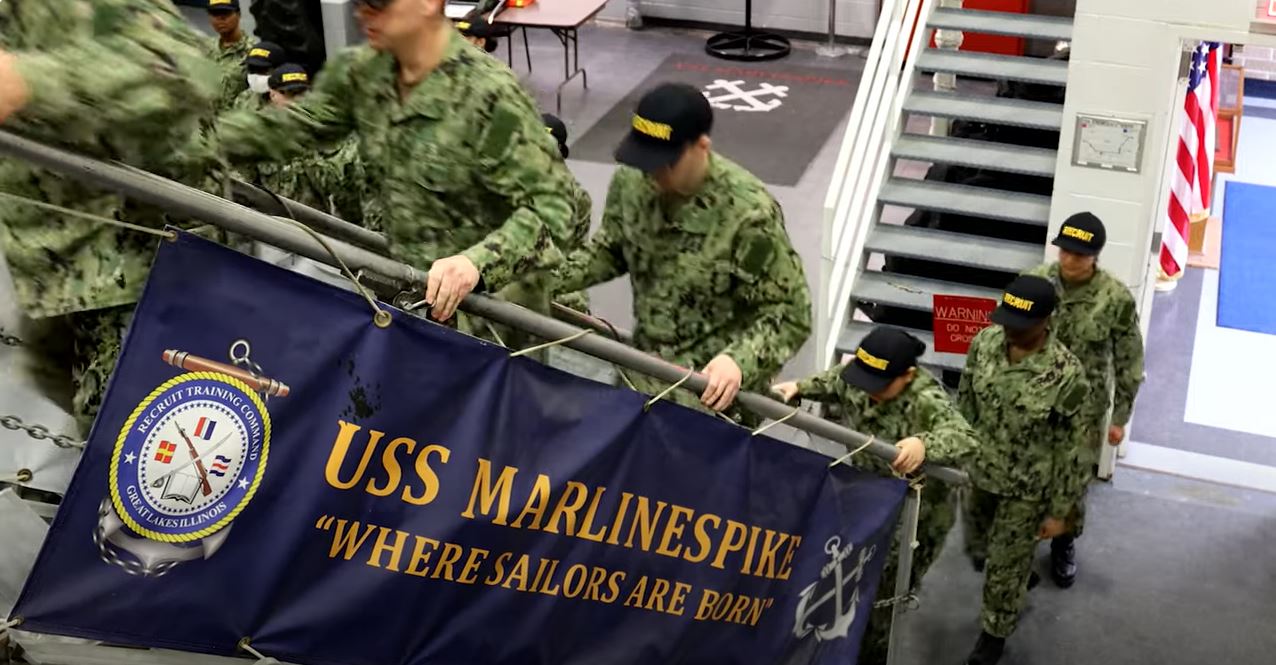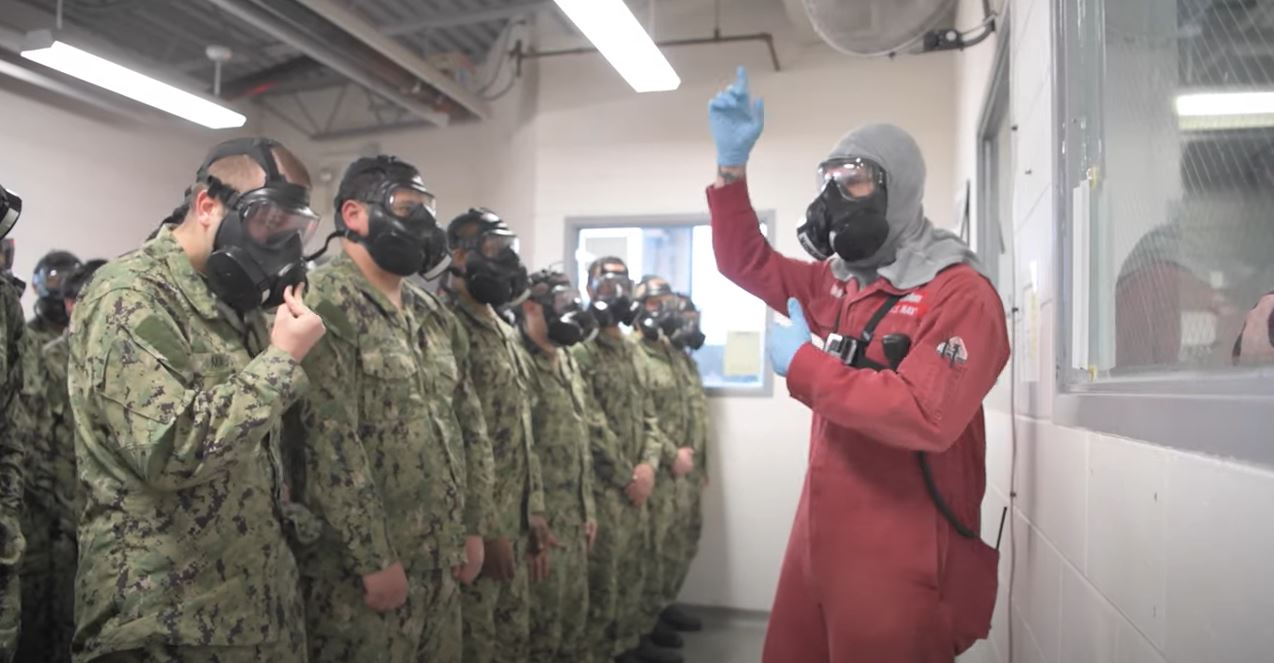Click here to view our Recruit Takeover video on the initial fitness event!
ARRIVAL & PROCESSING-DAYS
The moment civilians step off the bus onto Recruit Training Command, they have begun the transformation into Sailors. Recruits are split up into divisions and will meet their Recruit Division Commanders (RDCs). These will be the Sailors who will train them from recruits into Sailors.
Processing-Day Events
Phone Call (Arrival)
Night of Arrival/Moment of Truth
Pay/Admin
In-Processing
Initial Medical/Dental Screening
Haircuts
Initial Uniform Issue
Initial Fitness Event
Uniform Code of Military Justice (UCMJ)/Montgomery GI Bill (MGIB)
Orientation Briefs
Click here to view our Recruit Takeover video on the Swim Qualification
TRAINING WEEK 1
During week one, recruits will get their 3rd Class Swim Qualification. During this water survival course, recruits learn the basic survival-at-sea techniques, including lifeboat organization, survival kit contents, an abandon ship scenario, and the third-class swim qualification. The training ensures recruits can stay afloat and alive without using a personal floatation device in open water. This includes swimming 50 yards, a 5-minute prone float, and clothing inflation. The water survival instructors are certified experts in swim instruction, in-water rescue, lifeguarding, and CPR. Every Sailor graduating RTC must be a qualified swimmer.
Recruits are taught about the significance of the core values. Every Sailor is committed to embodying the core values of Honor, Courage, and Commitment. These values are essential in establishing a solid trust and leadership foundation, ultimately leading to our success and triumph. These principles have been the backbone of the U.S. Navy and the U.S. Marine Corps since their inception. They continue to serve as guiding principles today.
Week 1 Events:
Military Benefits
Uniforms and Grooming
Signature Behaviors
Force Protection
Watch standing
Armed Conflict Conduct
Click here to view our Recruit Takeover video on Uniform Issue
TRAINING WEEK 2
During week two, recruits learn about U.S. Navy ships and aircraft, Naval History, and the Uniform Code of Military Justice (UCMJ). During each Sailors Navy career, they will encounter many different platforms of ships and aircraft. The types of ships and aircraft have evolved to meet the challenge of changing warfare and doctrine. Since its inception on October 13th, 1775, the U.S. Navy has undergone significant technological, personnel, and operational changes. However, despite these changes, many of the Navy's customs, traditions, heritage, and courtesies have remained unchanged and remain integral to its identity and culture.
The Uniform Code of Military Justice (UCMJ) is a federal law that governs the military justice system. It consists of a complete set of criminal laws that cover many crimes punished under civilian law and other types of behavior that could disrupt good order and discipline in the military. The UCMJ is included in the United States Code, Title 10, Chapter 47.
They will have dental availability.
During Dental Availability, recruits with have an initial dental examination. The dental staff ensures that any crucial dental work is identified and completed. This promotes oral health and improves overall physical health and well-being.
Week 2 Events:
Enlisted Rate/Officer Rank
First Aid Training
Operational Stress Control Personnel and Material Inspections
Dress Uniform Issue
Knowledge Test I
Thrift Savings Plan
Phone Call I
Click here to view our Recruit Takeover video on Marlinspike

TRAINING WEEK 3
In week three of training, the recruits will be taught about Sexual Assault Prevention & Response (SAPR) and basic seamanship.
Basic seamanship skills are essential for all Navy sailors. These skills include line handling, shipboard watch standing, and sea and anchor detail. During their training, recruits will practice these skills on a simulated naval vessel called the USS Marlinespike.
The U.S. Navy's Sexual Assault Prevention and Response (SAPR) program is designed to meet the needs of victims. The Navy promotes and fosters a culturally aware fleet that is intolerant of sexual assault and supported by a program of prevention, advocacy, and accountability.
Recruits will also conduct a man-overboard drill and observe the Pass-in-Review ceremony of the graduating division.
Week 3 Events:
Man Overboard Drills
Basic Seamanship & Marlinspike Line Handling
Click here to view our Recruit Takeover video on the Confidence Chamber

TRAINING WEEK 4
During week four, recruits are introduced to Damage Control (DC). Each Navy Sailor must learn how to operate damage control equipment and systems necessary for damage control, ship stability, preservation of watertight integrity, firefighting, and Chemical, Biological, Radiological, and Nuclear Explosive (CBRNE) defense.
Recruits are familiarized with the damage control and firefighting curriculum. They learn the chemistry and classes of fires, how to don breathing devices, and how to complete the confidence chamber lab.
Week 4 Events:
Basic Damage Control
RDC PFA Assessment
Fire Fighting I & II Team Trainer
Phone Call II
Click here to view our Recruit Takeover video on Drill Inspections
TRAINING WEEK 5
In the fifth week of their training, recruits are introduced to the essential skills of weapons handling and the small arms trainer. This training phase is crucial, as it equips the recruits with the knowledge and expertise to handle weapons safely and effectively. During this phase, the recruits receive comprehensive training on marksmanship fundamentals, service pistol characteristics, clearing barrel procedures, and safety practices for the Navy Handgun Qualification Course. The training is designed to ensure that the recruits are proficient in handling weapons and can confidently complete the course. During week five, recruits are introduced to weapons handling and the small arms trainer. Weapons training consists of marksmanship fundamentals, service pistol characteristics, clearing barrel procedures, and weapons safety practices for completing the Navy Handgun Qualification Course.
Week 5 Events:
Weapons Familiarization
Small Arms Trainer
Drill Inspections
Live Fire Training
Click here to view our Recruit Takeover video on Fire Fighting
TRAINING WEEK 6
In the sixth week of their training, recruits are tested on their Damage Control skills. Each Sailor must protect the ship and their shipmates against the hazards of fire, smoke, and chemical weapon attacks. This phase of damage control will consist of hands-on fire team training.
Week 6 Events:
Personnel Inspection
Division Photo
Knowledge Test II
Fire Fighting Application
CLICK HERE TO VIEW OUR RECRUIT TAKEOVER VIDEO ON WARRIOR TOUGHNESS
TRAINING WEEK 7
During week seven, recruits complete their firefighting assessment and their final personnel inspection. Physical and mental preparation is crucial in developing resilience and strength to overcome fleet challenges. Warrior Toughness provides a holistic human skillset that enhances the toughness of our Sailors with a focus on the pursuit of peak performance.
Week 7 Events:
Final Personnel Inspection
Firefighting Assessment
Bystander Intervention I
Personal/Professional Development
Fleet & Family Support
Warrior Toughness Capstone
Click here to view our Recruit Takeover video on Battle Stations 21!
TRAINING WEEK 8
During week eight, recruits complete their capstone events, the Official Physical Fitness Assessment (PFA) and Battle Stations. Recruits must pass a Navy Physical Fitness Assessment and be within approved body composition
measurements for height and weight. Recruits are tested at the Battle Stations 21 training simulator aboard the USS Trayer. This 12-hour event culminates the past eight weeks of training in a comprehensive test. Each scenario begins with a short brief, in which recruits are given objectives and will provide details and answers to help them achieve those objectives--if they're paying enough attention.
Week 8 Events:
Final Drill Inspection
Official PFA
Battle Stations 21
DC Olympics
Phone Call 3 & 4
TRAINING WEEK 9
During week nine, recruits graduate boot camp during the Pass-in-Review Ceremony. The Pass-In-Review Ceremony is a formal military event that acknowledges the new recruits' hard work and dedication. It is a special occasion that brings together the future of the Navy with our long-held Naval traditions and customs.
Sailors wear their dress uniforms and leave the base for the first time as a reminder of their commitment to serve the country. They are Naval ambassadors to local civilians and everyone who sees them in their uniform.
Week 9 Events:
Ticket/Order Pickup
Photo Pick-up
Small Unit Leadership
Mentorship
Professional/ Personal Development Training
MyNavy Coaching
Liberty Brief
Graduation